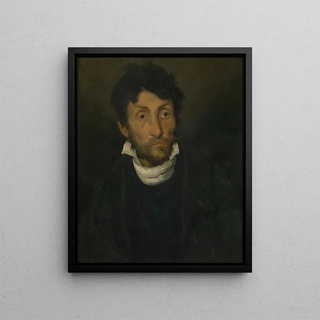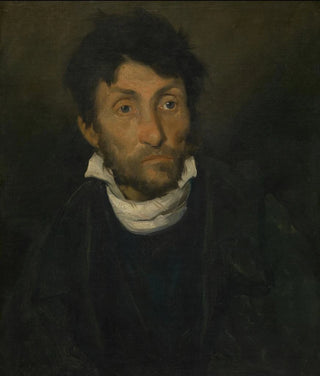Art print | Portrait of a kleptomaniac - Théodore Géricault


View from behind

Frame (optional)
Art print Portrait of a kleptomaniac - Théodore Géricault – Captivating introduction
The "Portrait of a kleptomaniac" by Théodore Géricault is a work that captivates with its boldness and psychological depth. Created in the early 19th century, this painting embodies not only the exceptional talent of its creator but also an era in full transformation, where art serves to depict the most intense human emotions. Immersing oneself in this universe, the viewer is invited to reflect on human nature, suffering, and marginality—themes that still resonate today. This portrait, both intimate and unsettling, offers a captivating glimpse into the psyche of an individual tormented by inner demons, while questioning societal perceptions of mental illness.
Style and uniqueness of the work
Géricault's style is distinguished by its realistic approach and attention to detail. In "Portrait of a kleptomaniac," the subject's features are accentuated, revealing an expression that is both vulnerable and desperate. Light and shadow, skillfully manipulated, create a striking contrast that emphasizes the dramatic tension of the scene. The colors, though dark, are vibrant and emotionally charged, while the composition, centered on the kleptomaniac's face, immediately captures the viewer's attention. Every brushstroke seems to tell a story, an inner struggle, inviting deep contemplation. This painting does not merely depict an individual; it becomes a mirror of human suffering, a silent cry that resonates within the souls of those who observe it.
The artist and his influence
Théodore Géricault, an emblematic figure of French Romanticism, is recognized for his ability to explore human passions and personal tragedies. His life, marked by tumultuous events, nourished his work and allowed him to develop a unique sensitivity. Géricault also engaged in representing society's marginalized, making them visible at a time when they were often ignored. His influence is felt not only in his own era but also in the artistic movements that followed. Artists like Delacroix and Courbet were inspired by his bold approach and his exploration of

Matte finish

View from behind

Frame (optional)
Art print Portrait of a kleptomaniac - Théodore Géricault – Captivating introduction
The "Portrait of a kleptomaniac" by Théodore Géricault is a work that captivates with its boldness and psychological depth. Created in the early 19th century, this painting embodies not only the exceptional talent of its creator but also an era in full transformation, where art serves to depict the most intense human emotions. Immersing oneself in this universe, the viewer is invited to reflect on human nature, suffering, and marginality—themes that still resonate today. This portrait, both intimate and unsettling, offers a captivating glimpse into the psyche of an individual tormented by inner demons, while questioning societal perceptions of mental illness.
Style and uniqueness of the work
Géricault's style is distinguished by its realistic approach and attention to detail. In "Portrait of a kleptomaniac," the subject's features are accentuated, revealing an expression that is both vulnerable and desperate. Light and shadow, skillfully manipulated, create a striking contrast that emphasizes the dramatic tension of the scene. The colors, though dark, are vibrant and emotionally charged, while the composition, centered on the kleptomaniac's face, immediately captures the viewer's attention. Every brushstroke seems to tell a story, an inner struggle, inviting deep contemplation. This painting does not merely depict an individual; it becomes a mirror of human suffering, a silent cry that resonates within the souls of those who observe it.
The artist and his influence
Théodore Géricault, an emblematic figure of French Romanticism, is recognized for his ability to explore human passions and personal tragedies. His life, marked by tumultuous events, nourished his work and allowed him to develop a unique sensitivity. Géricault also engaged in representing society's marginalized, making them visible at a time when they were often ignored. His influence is felt not only in his own era but also in the artistic movements that followed. Artists like Delacroix and Courbet were inspired by his bold approach and his exploration of






